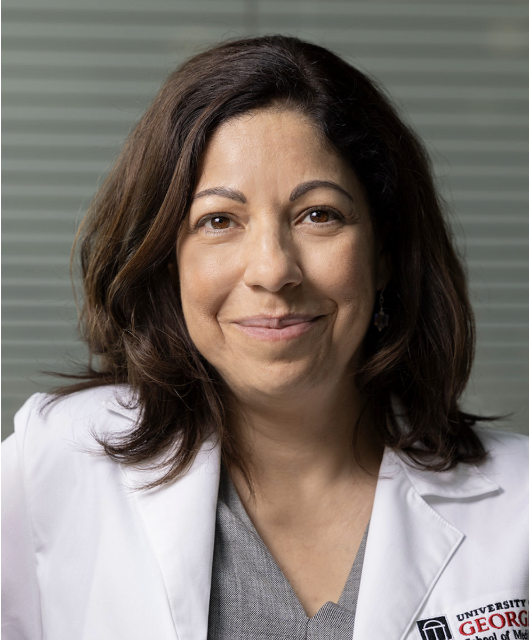Yana Zavros, Ph.D.
Molecular Medicine
The University of Georgia
Recruited: 2024
Discoveries in labs take considerable time to evolve into medical treatments. Yana Zavros works to accelerate the pace of this translation to benefit patients in great need, as soon as possible. This bench-to-bed urgency is a major reason she joined UGA in 2024 to launch and build an interdisciplinary research enterprise in the university’s new School of Medicine.
Raised in Australia with a Ph.D. from the University of Melbourne, Zavros came to the U.S. as a postdoc fellow at the prestigious Howard Hughes Medical Institute at the University of Michigan. She stayed to work in a research lab before being recruited to the University of Cincinnati in 2007; her 12 years in Cincinnati brought a rapid rise in the faculty ranks and a host of significant papers in her area of specialty, gastrointestinal disease.
Several of these journal articles centered on a protein called Sonic Hedgehog (Shh). A 2012 paper broke new ground in understanding how the Shh protein influences the development and function of the stomach. Shh sends signals that bring about the healthy growth and repair of tissue; but Zavros discovered that when the protein’s signaling pathway is disrupted, chaos can follow in the form of gastric diseases.
Zavros built on this discovery by:
- creating new ways to study how the stomach lining repairs itself;
- demonstrating how a bacterium (Helicobacter pylori) that’s linked to stomach ulcers interacts with cells to contribute to stomach cancer; and
- identifying how Shh signaling helps control the immune system as the stomach heals from illness or injury.
These and other findings made the Shh protein a promising target to help prevent and treat gastric diseases, including cancer.
While at the University of Cincinnati, Zavros also pioneered the use of organoids – miniature replicas of the body’s organs grown from tissue or pluripotent stem cells – as a tool for translational medicine. A protocol she developed opened up a new path for using the body’s immune system to fight cancer. Simplified, the protocol involves removing both blood and tumor tissue from a patient; creating an organoid of the tumor in vitro; then using immune cells from the blood to determine how the tumor suppresses immune response.
She tried that protocol using biospecimens from patients with a form of metastatic pancreatic cancer (ductal adenocarcinoma) to determine which anticancer drugs might be combined to treat the disease. One combination, Atezolizumab and Cabozantinib, showed promise. In early 2023, a Phase II clinical trial was fully underway to deliver this combination therapy to nearly three dozen patients. Thus, the protocol Zavros developed brought a potential new treatment much faster than traditional drug development approaches.
In 2019, the University of Arizona recruited Zavros to serve as associate head of research and as chief administrator of a research core in the University of Arizona Cancer Center. While at Arizona, she built on her organoid work and was part of a team that discovered a biomarker for stomach cancer. That discovery resulted in the first blood test for the disease, a non-invasive alternative to the customary biopsy method.
A turning point in Zavros’ career arrived in 2020, when she was diagnosed with a pituitary tumor and Cushing’s Disease, a rare and serious endocrine disorder. After successful surgery at the end of 2020, she decided to expand her research program to include Cushing’s, an understudied disease.
A first step was to replicate the organoid protocol she had developed earlier. Using tissue from pituitary tumors, Zavros developed organoid cultures that can be maintained, modified and preserved for study and testing. She also assembled an interdisciplinary research team across nine research universities and institutions and secured a $14 million grant from NIH to create a repository for such tumors. Called BioPitNeT, the biorepository will serve as an invaluable resource for scientists exploring new treatments for Cushing’s Disease and other ailments.
As Zavros and colleagues continue to build the biorepository, they are also conducting a molecular analysis of each tumor sample. The data from these analyses forms a kind of molecular atlas map to guide exploration of new biomarkers and drugs. One such biomarker was shown to identify a set of cancer stem cells that resist chemotherapy, thus revealing another potential target for treatment. Over time, Zavros expects other targets to emerge.
The research center Zavros is building inside UGA’s School of Medicine will focus sharply on blending different disciplines inside science and medicine. Translation is the primary aim: “My vision is that this will be the center that other institutions will look to as an example of how to successfully connect biomedical research and medicine in a way that rapidly translates scientific discovery to the patient,” she says.
Research
- In vitro and in vivo organoid systems to study gastric epithelial regeneration and disease mechanisms
- Immunological responses and disease progression associated with Helicobacter pylori infection, a bacterium linked to gastric diseases
- Sonic Hedgehog signaling pathway in gastrointestinal physiology and pathology
- Patient-derived gastric and pancreatic cancer organoids for personalized drug screening and studying tumor-immune system interactions to identify mechanisms fostering immunosuppressive tumor microenvironments
- Human and canine pituitary neuroendocrine tumor organoids to facilitate effective targeted treatments for conditions like Cushing's disease.
Choosing Georgia
“After visiting the University of Georgia, I loved the energy of the research environment, and the start of a new medical school presented an amazing opportunity. To be part of the team writing this chapter in UGA’s history is truly an opportunity of a lifetime. UGA provides an environment and infrastructure that support excellence and allow researchers to be successful and achieve their goals.”

